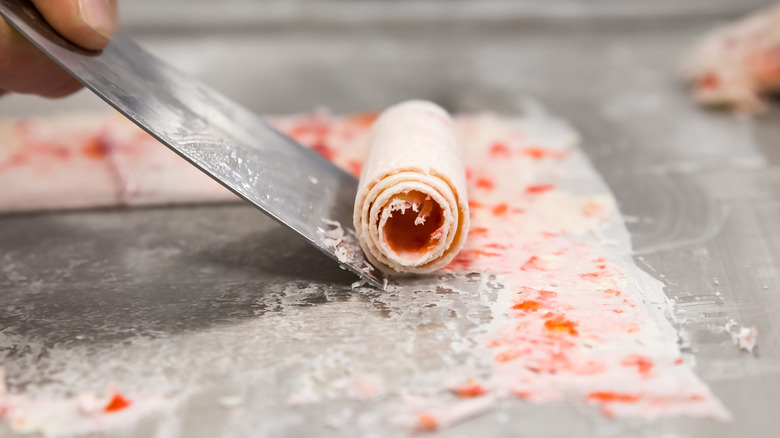Why Your Rolled Ice Cream Keeps Failing, And How To Fix It
If you've never tried to make rolled ice cream on your own, you won't understand the frustration that comes with spending time on all that prep just for the rolls to fail at the very last stage. It's probably akin to the disappointment of putting effort into a beautiful birthday cake just for it to topple over as you deliver it to the birthday girl. Rolled ice cream, otherwise known as stir-fried ice cream, originated in Thailand in the 2000s. The delicate and artfully crafted ice cream rolls began as street food, made their way to the U.S. in 2015, and took the internet by storm. Although making rolled ice cream can be time-consuming, it isn't all that hard. That is, unless, you run into problems at the very end. The success of rolled ice cream relies mainly on temperature and timing.
Some of the most common issues that arise at the actual rolling stage can be that the ice cream refuses to roll, collapses after rolling, or is too mushy and soft to roll at all. To fix this, the ice cream surface needs to be chilled so that the mixture stays firm enough to work with.
Rolled ice cream can be finicky and relies heavily on perfect execution from start to finish. With the right techniques and attention to detail though, you can create flawless, picture-perfect stir-fried ice cream in no time.
Troubleshooting rolled ice cream and perfecting your technique
Smooth, creamy, eye-catching rolled ice cream begins with the perfect base. You want it to be freezable, but still soft enough to shape. The key to creating an ideal base is to pour out an ice cream layer about ⅛ inch thick on your rolling surface. Too thin and the ice cream won't roll, too thick and the rolls will crack and collapse as you try to work with them. The base needs to cover the entire bottom of the baking sheet, otherwise, you run the risk of uneven slices that won't curl properly.
The next big issue to consider is temperature. A few hours before you begin preparation, you'll want to place a baking sheet in the freezer to let it get nice and frosty. Once you mix the ice cream base, take that baking sheet out of the freezer and pour the liquid onto the cold surface. Place the ice cream in the freezer and let it sit for at least four hours. If you take the ice cream out too soon, that's when you'll get that frustrating mushy consistency. You should also use an ice cream shaper or a spatula with a sharp edge to scrape up the ice cream. Thanks to a little extra preparation and attention to detail, making rolled ice cream at home can transform into a rewarding and delicious experience.

